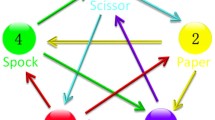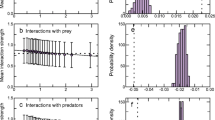Abstract
In order to understand the role of space in ecological communities where each species produces a certain type of resource and has varying abilities to exploit the resources produced by its own species and by the other species, we carry out a comparative study of an interacting particle system and its mean-field approximation. For a wide range of parameter values, we show both analytically and numerically that the spatial model results in predictions that significantly differ from its nonspatial counterpart, indicating that the use of the mean-field approach to describe the evolution of communities in which individuals only interact locally is invalid. In two-species communities, the disagreements between the models appear either when both species compete by producing resources that are more beneficial for their own species or when both species cooperate by producing resources that are more beneficial for the other species. In particular, while both species coexist if and only if they cooperate in the mean-field approximation, the inclusion of space in the form of local interactions may prevent coexistence even in cooperative communities. Introducing additional species, cooperation is no longer the only mechanism that promotes coexistence. We prove that, in three-species communities, coexistence results either from a global cooperative behavior, or from rock-paper-scissors type interactions, or from a mixture of these dynamics, which excludes in particular all cases in which two species compete. Finally, and more importantly, we show numerically that the inclusion of space has antagonistic effects on coexistence depending on the mechanism involved, preventing coexistence in the presence of cooperation but promoting coexistence in the presence of rock-paper-scissors interactions. Although these results are partly proved analytically for both models, we also provide somewhat more explicit heuristic arguments to explain the reason why the models result in different predictions.
Similar content being viewed by others

References
Clifford, P., & Sudbury, A. (1973). A model for spatial conflict. Biometrika, 60, 581–588.
Cox, J. T. (1989). Coalescing random walks and voter model consensus times on the torus in ℤd. Ann. Probab., 17, 1333–1366.
Cox, J. T., & Griffeath, D. (1986). Diffusive clustering in the two-dimensional voter model. Ann. Probab., 14, 347–370.
Durrett, R., & Levin, S. A. (1994). Stochastic spatial models: a user’s guide to ecological applications. Philos. Trans. R. Soc. Lond. Ser. B, 343, 329–350.
Durrett, R., & Levin, S. A. (1994). The importance of being discrete (and spatial). Theor. Popul. Biol., 46, 363–394.
Erdős, P., & Ney, P. (1974). Some problems on random intervals and annihilating particles. Ann. Probab., 2, 828–839.
Hofbauer, J., & Sigmund, K. (1998). Evolutionary games and population dynamics. Cambridge: Cambridge University Press.
Holley, R. A., & Liggett, T. M. (1975). Ergodic theorems for weakly interacting systems and the voter model. Ann. Probab., 3, 643–663.
Huffaker, C. B. (1958). Experimental studies on predation: dispersion factors and predator-prey oscillations. Hilgardia, 27, 343–383.
Hutson, V. (1984). A theorem on average Liapunov functions. Monatshefte Math., 98, 267–275.
Lanchier, N. (2011). Two-strategy games on the lattice. Preprint.
Lanchier, N., & Neuhauser, C. (2009). Spatially explicit non Mendelian diploid model. Ann. Appl. Probab., 19, 1880–1920.
Liggett, T. M. (1994). Coexistence in threshold voter models. Ann. Probab., 22, 764–802.
Neuhauser, C. (2001). Mathematical challenges in spatial ecology. Not. Am. Math. Soc., 48, 1304–1314.
Neuhauser, C., & Pacala, S. W. (1999). An explicitly spatial version of the Lotka–Volterra model with interspecific competition. Ann. Appl. Probab., 9, 1226–1259.
Schwartz, D. (1978). On hitting probabilities for an annihilating particle model. Ann. Probab., 6, 398–403.
Sinervo, B., & Lively, C. M. (1996). The Rock-Paper-Scissors Game and the evolution of alternative male strategies. Nature, 380, 240–243.
Author information
Authors and Affiliations
Corresponding author
Additional information
Research of N. Lanchier supported in part by NSF Grant DMS-10-05282.
Rights and permissions
About this article
Cite this article
Kang, Y., Lanchier, N. The Role of Space in the Exploitation of Resources. Bull Math Biol 74, 1–44 (2012). https://doi.org/10.1007/s11538-011-9649-1
Received:
Accepted:
Published:
Issue Date:
DOI: https://doi.org/10.1007/s11538-011-9649-1



